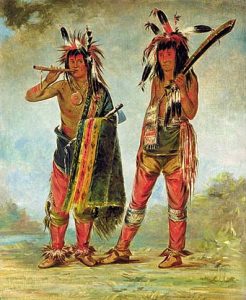Understanding the Chickasaw Tribe of the origin of the Chickasaw tribe is still uncertain as it only is referenced around the various stories that are coming from the elders of the tribe as of today.
Understanding the Chickasaw Tribe
However, based on 20th-century scholars and academies, the Chickasaw and Choctaw tribes have split into two different people by the start of the 17th century. They were from the people who followed the Plaquemine culture who have settled in the Lower Mississippi Valley for more or less one thousand years.
In the 16th century, when European explorers discovered them, the Chickasaw tribe were settled in villages located in the northeastern Mississippi. This surprised the Europeans as they previously thought that people in the unknown world are primitive in a sense that they do not have a permanent settlement and no form of any kind of government. This proved them wrong, and in the process, the Chickasaw tribe earned the respect of the soon to be conquerors.
The Chickasaw tribe have then transferred their settlement to the Mississippi River. They migrated together with the Choctaw tribe from the western part of the Mississippi River into what is now present-day Mississippi.

Thus, the Mississippian Ideological Interaction Sphere was spanning throughout the Eastern Woodlands. This is very important as this secured the hold and status of the Chickasaw tribe in the woodlands area, being regarded as one of the superior tribes in the region. This gained them the respect, resulting in the less frequent attacks from rival Native American tribes. The cultures that are present in the Mississippi region have emerged from being mound-building societies until the year 880.
Dense and complex villages were built by them. This was very important as it supports the stratified society that they have. This is located and centers in the Mississippi and Ohio River Valleys. This was their chosen place because of the abundance of fish supplies that they used for food. Based on historical records, the Chickasaw Old Fields were located somewhere in Madison County, Alabama. There is another version of the origin story of the Chickasaws where they are from the Nanih Waiya. This is a humongous earthwork mound that was built on 300 by the people of the Woodlands.
The Choctaw people also treat this to be a sacred ground, as they share a similar origin story with the Chickasaw tribe.
The mound was built roughly 1400 years ago before the official unification of the river valley people into becoming the unified Chickasaw tribe.
By the start of the 15th century, the Chickasaw people have left the Tombigbee Valley following the fall of the Moundville chiefdom. They then transferred to the upper portion of the Yazoo and Pearl River Valleys which are still located in Mississippi. Even though they have transferred their settlement, there was really no big deal with this because it is still very similar to their original settlement near the Ohio River Valley. It was even a very good thing for them because the fish supplies and other marine life are more abundant there.
chickasaw removal, how many Chickasaw died on the trail of tears, Chickasaw removal trail of tears, what happened to the Chickasaw tribe, what problems did the Chickasaws encounter in Indian territory, Chickasaw removal timeline describes the Chickasaw removal, which was least harmful, Chickasaw response to removal
